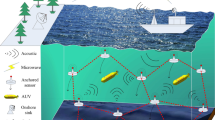Abstract
Most of underwater wireless sensor applications need reliable data transfer timely and efficiently. Because radio waves do not travel well through good electrical conductors like saltwater, underwater distributed systems use acoustic waves to communicate data. However, energy conservation is a major challenge in underwater acoustic-based systems/networks. Different methods are developed to enhance energy efficiency in these networks. In this paper, we improve energy efficiency of the networks by enhancing routing scheme. The enhancement is done by defining some constraints on traditional packet flooding. A strategy based on physical constraints has been introduced in our previous work for creating an indirect 1-D random mechanism to remove additional nodes from routing process and save energy. Now here, a better mechanism in terms of simplicity, scalability and efficiency is introduced to improve energy consumption. The approach is to use an intelligent 3-D random node removal mechanism considering traffic status of the network. Simulation results show that the proposed approach significantly improves energy efficiency of the underwater acoustic wireless sensor networks.










Similar content being viewed by others
References
Ayaz M, Baig I, Abdullah A, Faye I (2011) A survey on routing techniques in underwater wireless sensor networks. J Netw Comput Appl 34:1908–1927
Khosravi MR, Basri H, Rostami H (2018) Efficient ROUTING FOR DENSE UWSNs with high-speed mobile nodes using spherical divisions. J Supercomput. https://doi.org/10.1007/s11227-017-2148-x
Proakis JG, Rice JA, Sozer EM, Stojanovic M (2001) Shallow water acoustic networks. IEEE Commun Mag 39:114–119
Sharif-Yazd M, Khosravi M, Moghimi M (2017) A survey on underwater acoustic sensor networks: perspectives on protocol design for signaling, MAC and routing. J Comput Commun 5:12–23
Niculescu D, Nath B (2003) Trajectory based forwarding and its applications. In: Proceedings of the 9th Annual International Conference on Mobile Computing and Networking (MOBICOM’03), San Diego
Xie P, Cui J, Lao L (2006) VBF: vector-based forwarding protocol for underwater sensor networks. In: Proceedings of the IFIP Conference: Networking Technologies, Services and Protocols Performance of Computer and Communication Networks, Mobile and Wireless Communications Systems
Xie P, Zhou Z, Nicolaou N, See A, Cui J, Shi Z (2010) Efficient vector-based forwarding for underwater sensor networks. EURASIP J Wirel Commun Netw 2010:195910
Pompili D, Melodia T (2005) Three-dimensional routing in underwater acoustic sensor networks. In: Proceedings of the 2nd ACM International Workshop on Performance Evaluation of Wireless Ad Hoc, Sensor, and Ubiquitous Networks (WASUN’05), Montreal
Abbasi AA, Younis M (2007) A survey on clustering algorithms for wireless sensor networks. Comput Commun 30:2826–2841
Yu H, Yao N, Liu J (2014) An adaptive routing protocol in underwater sparse acoustic sensor networks. Ad-Hoc Netw 34:121–143
Ibrahim DM (2014) Enhancing the vector-based forwarding routing protocol for underwater wireless sensor networks: a clustering approach. In: Proceedings of the 10th International Conference on Wireless and Mobile Communications, pp 98–104
Basri H, Rostami H, Khosravi MR (2015) Improvement of energy consumption in dense underwater sensor networks. In: Proceedings of the IT2015, Shahid Beheshti University (SBU), Tehran
Pouryazdanpanah M (2014) DS-VBF: dual sink vector-based routing protocol for underwater wireless sensor network. In: Proceedings of the 5th Control and System Graduate Research Colloquium, Malaysia
Khosravi MR, Basri H, Rostami H (2016) Energy efficient random cooperations for VBF-based routing in dense UWSNs. In: Proceedings of the ICNRAECE’16, Amirkabir University of Technology (AUT), Tehran
Chen Y, Juang T, Lin Y, Tsai I (2010) A low propagation delay multi-path routing protocol for underwater sensor networks. J Internet Technol 11:153–165
Hao K, Jin Z, Shen H, Wang Y (2015) An efficient and reliable geographic routing protocol based on partial network coding for underwater sensor networks. Sensors 15:12720–12735
Dhurandher SK, Obaidat MS, Gupta M (2011) An efficient technique for geocast region holes in underwater sensor, networks and its performance evaluation. Simul Model Pract Theory 19:2102–2116
Dhurandher SK, Obaidat MS, Gupta M (2013) Energized geocasting model for underwater wireless sensor networks. Simul Model Pract Theory 37:125–138
Ahmed M, Salleh M, Channa M (2017) Routing protocols based on node mobility for underwater wireless sensor network (UWSN): a survey. J Netw Comput Appl 78:242–252
Cai S, Gao Z, Yang D, Yao N (2013) A network coding based protocol for reliable data transfer in underwater acoustic sensor. Ad Hoc Netw 11:1603–1609
Sun N, Han G, Zhang J, Wu T, Jiang J, Shu L (2016) RLER: a reliable location-based and energy-aware routing protocol for underwater acoustic sensor networks. J Internet Technol 17(2):349–357
Yan H, Shi Z, Cui J (2008) DBR: depth-based routing for underwater sensor networks. In: Proceedings of the 7th IFIP-TC6 Networking Conference on Ad-Hoc and Sensor Networks
Papoulis A, Pillai SU (2002) Probability, random variables, and stochastic processes. McGraw-Hill, New York
Faheem M, Tuna G, Gungor V (2017) QERP: quality-of-service (QoS) aware evolutionary routing protocol for underwater wireless sensor networks. IEEE Syst J PP:1–8
Xie P (2009) Aqua-Sim: an NS-2 based simulator for underwater sensor networks. In: Proceedings of the OCEANS2009
Nicolaou N, See A, Xie P, Cui J, Maggiorini D (2007) Improving the robustness of location-based routing for underwater sensor networks. In: Proceedings of the OCEANS2007, Aberdeen
Alhihi M (2017) Practical routing protocol models to improve network performance and adequacy. J Comput Commun 5:114–124
Khosravi MR, Samadi S, Akbarzadeh O (2017) Determining the optimal range of angle tracking radars. In: IEEE International Conference on Power, Control, Signals and Instrumentation Engineering (ICPCSI 2017), pp 3132–3135
Alhihi M, Khosravi MR (2018) Formulizing the fuzzy rule for Takagi–Sugeno model in network traffic control. Open Electr Electron Eng J 12(1):1–11
Torabi A, Er MJ, Li X, Lim BS (2016) Sequential fuzzy clustering based dynamic fuzzy neural network for fault diagnosis and prognosis. Neurocomputing 18:636–656
Alhihi M, Khosravi MR, Attar H, Samour M (2017) Determining the optimum number of paths for realization of multi-path routing in MPLS-TE networks. Telkomnika 15(4):1701–1709
Author information
Authors and Affiliations
Corresponding author
Rights and permissions
About this article
Cite this article
Khosravi, M.R., Basri, H., Rostami, H. et al. Distributed random cooperation for VBF-based routing in high-speed dense underwater acoustic sensor networks. J Supercomput 74, 6184–6200 (2018). https://doi.org/10.1007/s11227-018-2532-1
Published:
Issue Date:
DOI: https://doi.org/10.1007/s11227-018-2532-1




